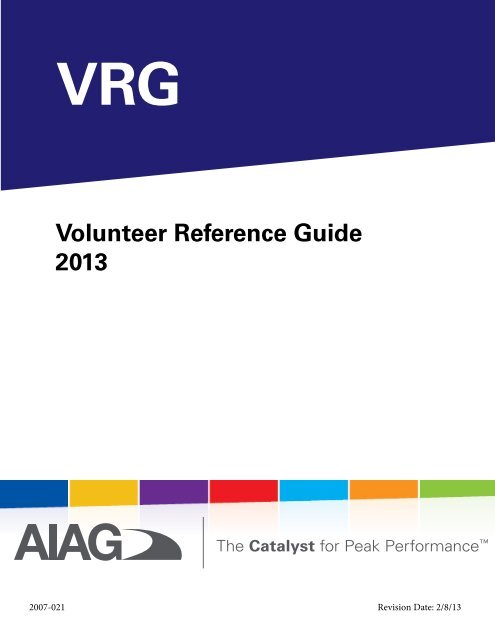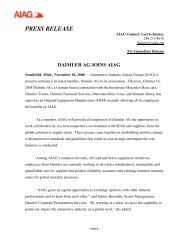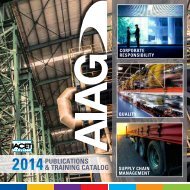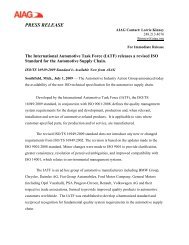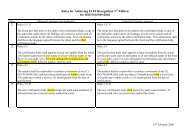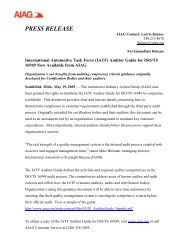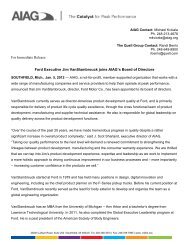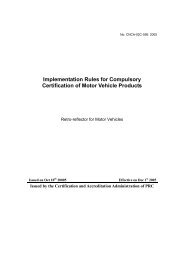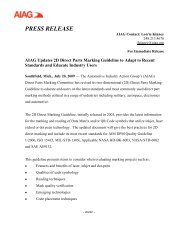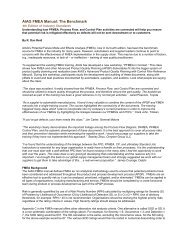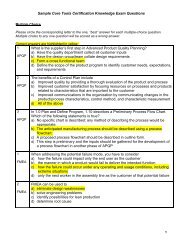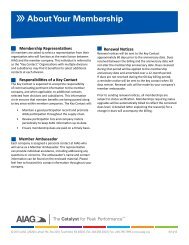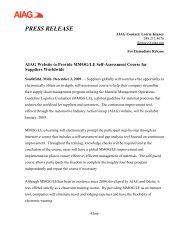Volunteer Reference Guide 2012 - Automotive Industry Action Group
Volunteer Reference Guide 2012 - Automotive Industry Action Group
Volunteer Reference Guide 2012 - Automotive Industry Action Group
Create successful ePaper yourself
Turn your PDF publications into a flip-book with our unique Google optimized e-Paper software.
VRG<br />
<strong>Volunteer</strong> <strong>Reference</strong> <strong>Guide</strong><br />
2013<br />
2007-021 Revision Date: 2/8/13
The Catalyst for Peak Performance<br />
<strong>Volunteer</strong> <strong>Reference</strong> <strong>Guide</strong><br />
Policies, Procedures, and Examples<br />
for Administration of <strong>Volunteer</strong> Committees<br />
2013<br />
2007-021 Revision 2/8/13
<strong>Volunteer</strong> <strong>Reference</strong> <strong>Guide</strong><br />
Table of Contents<br />
VOLUNTEER REFERENCE GUIDE ................................................................................................................. 1<br />
TABLE OF CONTENTS ................................................................................................................................................. 1<br />
PURPOSE .................................................................................................................................................................... 3<br />
ENDS ........................................................................................................................................................................ 3<br />
AIAG ORGANIZATIONAL STRUCTURE ............................................................................................................. 4<br />
VOLUNTEER COMMITTEES ................................................................................................................................. 6<br />
VOLUNTEER COMMITTEES ................................................................................................................................ 6<br />
PARTICIPATION IN COMMITTEE MEETINGS .................................................................................................. 9<br />
AIAG MEMBER PARTICIPATION ........................................................................................................................ 9<br />
VOLUNTEER COMMITTEE LEADERSHIP (OFFICERS) ................................................................................... 9<br />
AIAG MEETINGS .................................................................................................................................................... 11<br />
DEFINITION OF A MEETING .............................................................................................................................. 11<br />
TYPES OF MEETINGS .......................................................................................................................................... 11<br />
ANTI-TRUST REQUIREMENTS .......................................................................................................................... 11<br />
PRESENTATION OF PRODUCTS OR SERVICES AT AIAG VOLUNTEER MEETINGS ................................ 11<br />
REPRESENTING AIAG ......................................................................................................................................... 12<br />
EXPENSES ............................................................................................................................................................. 13<br />
DOCUMENTING VOLUNTEER COMMITTEE MEETINGS ........................................................................... 14<br />
THE MEETING AGENDA ..................................................................................................................................... 14<br />
MEETING MINUTES ............................................................................................................................................ 14<br />
SECRETARY ......................................................................................................................................................... 14<br />
CONTENTS OF MEETING MINUTES ................................................................................................................. 14<br />
DOCUMENTING DISCUSSIONS AND DECISIONS IN MINUTES .................................................................. 14<br />
USE OF NAMES IN MEETING MINUTES .......................................................................................................... 20<br />
SUBMISSION FORMAT OF MINUTES ............................................................................................................... 20<br />
DISTRIBUTION OF MINUTES............................................................................................................................. 20<br />
RECORD KEEPING ............................................................................................................................................... 20<br />
DECISION MAKING IN VOLUNTEER COMMITTEE MEETINGS ............................................................... 22<br />
THE FORMAL CONSENSUS PROCESS .............................................................................................................. 22<br />
CLARIFYING THE PROCESS .............................................................................................................................. 23<br />
PRESENTING A PROPOSAL ................................................................................................................................ 23<br />
IDENTIFYING INDIVIDUAL CONCERNS ABOUT THE PROPOSAL ............................................................. 24<br />
ADDRESSING EACH CONCERN ........................................................................................................................ 24<br />
RESOLVING EACH CONCERN ........................................................................................................................... 24<br />
TAKING OWNERSHIP OF “STAND ASIDE” CONCERNS ................................................................................ 24<br />
ACHIEVING CONSENSUS ON THE PROPOSAL .............................................................................................. 25<br />
DEALING WITH LACK OF CONSENSUS .......................................................................................................... 25<br />
VOTING .................................................................................................................................................................... 25<br />
ONE COMPANY, ONE VOTE .............................................................................................................................. 27<br />
VOTING IN FULL MEMBERSHIP BALLOT ....................................................................................................... 27<br />
VOTING IN COMMITTEE MEETINGS ............................................................................................................... 27<br />
ATTENDANCE REQUIREMENT FOR COMMITTEE VOTING ........................................................................ 28<br />
PROJECT MANAGEMENT METHODOLOGY .................................................................................................. 29<br />
PROJECT MANAGEMENT PROCESS ................................................................................................................ 29<br />
2007-021 1 Revision Date: 2/8/13
<strong>Volunteer</strong> <strong>Reference</strong> <strong>Guide</strong><br />
PROJECT MANAGEMENT .................................................................................................................................. 29<br />
PROJECT MANAGEMENT WORK PHASES ...................................................................................................... 29<br />
E-COMMUNITIES ................................................................................................................................................... 31<br />
APPENDIX A: GENERAL POLICIES ................................................................................................................... 32<br />
ANTI-TRUST POLICY .......................................................................................................................................... 32<br />
COPYRIGHT POLICY ................................................................................................................................................. 34<br />
CONFLICT OF INTEREST POLICY ..................................................................................................................... 34<br />
ENDORSEMENT POLICY .................................................................................................................................... 35<br />
PRESENTATION OF PRODUCTS OR SERVICES AT AIAG VOLUNTEER MEETINGS ................................ 35<br />
MEMBER LISTS .................................................................................................................................................... 35<br />
EXPENDITURE APPROVAL POLICY ................................................................................................................ 36<br />
DRESS CODE ......................................................................................................................................................... 36<br />
HARASSMENT PREVENTION POLICY ............................................................................................................. 36<br />
NON-MEMBER POLICY ...................................................................................................................................... 36<br />
APPENDIX B: FRAUDULENT OR DISHONEST CONDUCT & WHISTLEBLOWER POLICY<br />
STATEMENT ............................................................................................................................................................ 38<br />
DEFINITIONS ............................................................................................................................................................ 38<br />
RIGHTS AND RESPONSIBILITIES ................................................................................................................................ 39<br />
TABLES<br />
TABLE 1. AIAG PROJECT MANAGEMENT STAFF AND FUNCTIONS ................................................................................. 5<br />
TABLE 2. COMMITTEE ROLES AND RESPONSIBILITIES .................................................................................................... 7<br />
TABLE3. FUNCTIONS OF VOLUNTEER COMMITTEE LEADERS ....................................................................................... 10<br />
TABLE 9. VOTING POLICY AS APPLIED TO CONSULTANTS ............................................................................................ 27<br />
FIGURES<br />
FIGURE 1. SAMPLE MINUTES FORMAT ......................................................................................................................... 16<br />
FIGURE 3. FORMAL PROCESS FOR ACHIEVING CONSENSUS .......................................................................................... 23<br />
FIGURE 4. AIAG VOTING PROCEDURE ......................................................................................................................... 26<br />
FIGURE 5. PROJECT MANAGEMENT WORK PHASES ...................................................................................................... 30<br />
2007-021 2 Revision Date 2/8/13
<strong>Volunteer</strong> <strong>Reference</strong> <strong>Guide</strong><br />
PURPOSE<br />
Founded in 1982, AIAG is a globally recognized organization where OEMs and suppliers unite to address<br />
and resolve issues affecting the worldwide automotive supply chain. AIAG’s goals are to reduce cost<br />
and complexity through collaboration; improve product quality, health, safety and the environment; and<br />
optimize speed to market throughout the supply chain.<br />
ENDS<br />
AIAG’s Board of Directors has defined the following as the Ends towards which all efforts at AIAG<br />
should be directed:<br />
AIAG exists so the automotive and related industries will have:<br />
• a seamless, efficient, and responsible supply chain for the global automotive and related industries,<br />
with:<br />
- cost and complexity reduced<br />
- quality, health, safety, and environment improved<br />
- speed to market optimized<br />
• a leading global resource for valued direction and solutions on automotive and related industry<br />
business processes between trading partners.<br />
- Access to the information and education needed to drive effective and efficient<br />
implementation of common best practices and consensus agreements developed at AIAG.<br />
• AIAG members have insight into emerging global issues and active representation of industry needs<br />
nationally and internationally.<br />
2007-021 3 Revision Date2/8/13
<strong>Volunteer</strong> <strong>Reference</strong> <strong>Guide</strong><br />
AIAG ORGANIZATIONAL STRUCTURE<br />
<strong>Automotive</strong> <strong>Industry</strong> <strong>Action</strong> <strong>Group</strong> (AIAG) committees are made up of volunteers from its member<br />
companies – the automotive industry itself. As a volunteer, you are AIAG. The AIAG staff supports the<br />
efforts of the volunteers and handles the administrative issues.<br />
Our board of directors provides long-range strategic leadership and monitoring of performance on behalf<br />
of the AIAG membership. The executive director reports to the board of directors and manages all aspects<br />
of AIAG’s operations. <strong>Industry</strong> loaned executives, directors, program managers, a full-time staff, and<br />
individuals who support volunteer committees complete the organization.<br />
The purpose of assigning roles and responsibilities ensures that tasks are completed in a timely manner<br />
and without duplication. The Project Management staff is made up of <strong>Industry</strong> Loaned Executives,<br />
Business Unit Directors, Program Managers, and Project Coordinators:(See matrix on following page)<br />
2007-021 4 Revision Date 2/8/13
<strong>Volunteer</strong> <strong>Reference</strong> <strong>Guide</strong><br />
Table 1. AIAG Project Management Staff and Functions<br />
2007-021 5 Revision Date2/8/13
<strong>Volunteer</strong> <strong>Reference</strong> <strong>Guide</strong><br />
VOLUNTEER COMMITTEES<br />
<strong>Volunteer</strong> committees are organized teams of individuals from member companies. Based on individual<br />
interest and expertise, the volunteers work on various AIAG projects.<br />
VOLUNTEER COMMITTEES<br />
• Must go through an approval process when formed<br />
• Must follow the established policies and procedures for volunteer committee meetings<br />
Table 2 shows the various committees and what they do.<br />
2007-021 6 Revision Date 2/8/13
<strong>Volunteer</strong> <strong>Reference</strong> <strong>Guide</strong><br />
Table 2. Committee Roles and Responsibilities<br />
2007-021 7 Revision Date2/8/13
<strong>Volunteer</strong> <strong>Reference</strong> <strong>Guide</strong><br />
2007-021 8 Revision Date 2/8/13
<strong>Volunteer</strong> <strong>Reference</strong> <strong>Guide</strong><br />
PARTICIPATION IN COMMITTEE MEETINGS<br />
Meetings consist of three or more individuals gathering to address AIAG issues; either at AIAG offices in<br />
Southfield, Michigan or off-site (as approved by the appropriate program manager). Attendance must be<br />
taken at all meetings and recorded on attendance sign-in sheets. Minutes are required to be taken at every<br />
meeting and submitted for archiving to AIAG. Meetings are not limited in size.<br />
AIAG MEMBER PARTICIPATION<br />
The opportunity to volunteer for any work group is open to all AIAG members based on the project skills<br />
requirements. Steering committee meetings are attended by invitation only. Participation in AIAG<br />
volunteer committees by associate members is limited to a single, specific individual.<br />
Copyright Policy<br />
AIAG’s copyright policy state that all products developed by AIAG groups are the property of<br />
and are copyrighted by AIAG with the exception of those created jointly with another<br />
organization and covered by separate agreement.<br />
Ownership of intellectual property contributed to AIAG transfers to AIAG as soon as the<br />
development of the document begins. If the intellectual property that is contributed is copyrighted,<br />
written permission to use the intellectual property is required and the permission statement will be<br />
included in the document.<br />
AIAG will acknowledge such contributors in each publication.<br />
VOLUNTEER COMMITTEE LEADERSHIP (OFFICERS)<br />
<strong>Volunteer</strong> committees are self-administered. Leadership consists of:<br />
• Chair/Co-chairs<br />
• Vice Chair/Co-Vice Chairs<br />
• Secretary/Co-Secretaries<br />
• Document Coordinator (if committee is developing a publication or product)<br />
Each steering committee and on-going work group or project team must elect its leadership on a calendar<br />
year basis.<br />
The functions of each position are explained in Table 3.<br />
2007-021 9 Revision Date2/8/13
Table3. Functions of <strong>Volunteer</strong> Committee Leaders<br />
<strong>Volunteer</strong> <strong>Reference</strong> <strong>Guide</strong><br />
2007-021 10 Revision Date 2/8/13
<strong>Volunteer</strong> <strong>Reference</strong> <strong>Guide</strong><br />
AIAG MEETINGS<br />
DEFINITION OF A MEETING<br />
Any volunteer committee meeting that is held at AIAG headquarters or off-site (including audio<br />
teleconferences) is considered an official AIAG meeting if the following two situations apply:<br />
• The meeting has employees of three or more member companies in attendance who are not full-time<br />
AIAG employees or industry loaned executives.<br />
• The topic of discussion is a proposed or current AIAG project or other volunteer committee activity<br />
(such as special presentations or liaison with other associations).<br />
Not included are meetings where one or more AIAG staff members are present and that are held solely for<br />
the purpose of discussing AIAG staff/association business.<br />
TYPES OF MEETINGS<br />
There are three types of AIAG meetings:<br />
1. In-house meetings: held at the AIAG offices in Southfield, Michigan<br />
2. Sponsored off-site meetings: held at a site other than the AIAG offices, where the facilities,<br />
equipment, and refreshments are provided by an organization other than AIAG (e.g., the meeting<br />
is held in the offices of a member of the committee)<br />
3. Unsponsored off-site meetings: held at a site other than the AIAG offices, where the facilities are<br />
paid for by AIAG. Such meetings must be in the committee’s business plan and budget, and<br />
require the signature of the product development director on the off-site meeting request form.<br />
ANTI-TRUST REQUIREMENTS<br />
Anti-trust compliance requires that every official AIAG meeting, whether held in AIAG offices or off-site,<br />
must have:<br />
• Public announcement of the meeting date, time, and location<br />
• Full documentation of the meeting, including:<br />
- An agenda published in advance<br />
- Minutes listing every topic of discussion<br />
- A complete list of all attendees, including teleconference attendees<br />
Because of legal considerations, the executive director must authorize any exceptions to these<br />
requirements in advance<br />
PRESENTATION OF PRODUCTS OR SERVICES AT AIAG VOLUNTEER MEETINGS<br />
AIAG will not endorse any publication, training offering, or other product or service provided by an<br />
outside party. Therefore, AIAG does not allow vendors to present, demonstrate, or advertise their<br />
products in any manner that might give the impression that AIAG is endorsing that product. For this<br />
reason, sales or promotion of products is strictly prohibited during AIAG volunteer meetings.<br />
2007-021 11 Revision Date2/8/13
<strong>Volunteer</strong> <strong>Reference</strong> <strong>Guide</strong><br />
Vendors may not use the sign-in sheets from AIAG volunteer meetings to send promotional materials or<br />
announcements by any method. AIAG provides the opportunity for promotion of vendor products through<br />
exhibit space at conferences and events.<br />
From time to time, AIAG volunteer groups may invite vendors to present information about their<br />
products and services when such information is relevant to a process or technology that the committee is<br />
reviewing as part of its work. In these instances the following principles apply:<br />
• The invitation to include vendor presentations in the meeting must be approved in advance by a<br />
program manager.<br />
• The presentation(s) must be announced in the published agenda of the committee at least two weeks<br />
before the meeting.<br />
• The committee must document (in the minutes of the committee) the purpose for which vendors are<br />
being invited to present and the questions that must be answered in the presentation.<br />
• The committee must make a reasonable effort to invite all known vendors whose offerings are<br />
relevant to the subject and must document their efforts in the minutes of the committee. Such efforts<br />
might include letters to a list of vendors, an announcement in a trade magazine soliciting responses,<br />
or other methods.<br />
• The vendor’s presentation:<br />
- Must not include promotional material.<br />
- Must be relevant to the committee’s documented questions.<br />
No sales or promotional efforts, including the distribution of sales literature or promotional items, may be<br />
conducted during the meetings or at breaks before, during, or immediately after the meeting.<br />
REPRESENTING AIAG<br />
From time to time, AIAG volunteers are called upon to represent AIAG at meetings/activities both in this<br />
country and abroad. If you have been requested to travel representing AIAG, please consider the<br />
following:<br />
When you express an opinion on an issue, clearly identify whether you are speaking for your company or<br />
for AIAG, if applicable.<br />
• Be sure to get feedback from the appropriate volunteer committees regarding the issues you will be<br />
addressing to ensure that you are offering the consensus of the group sponsoring the trip rather than<br />
just your own personal opinion.<br />
• Compile a list of issues that the AIAG volunteer committees want addressed as well as any specific<br />
questions the group may have.<br />
• Remember that in most cases you will be speaking for AIAG and not your own company. If you will<br />
be representing both your company individually and AIAG at the same time, be sure to announce<br />
that fact at the start of the meeting.<br />
• The AIAG position should be presented as a single, consensus-based agreement. When attending a<br />
meeting with others from AIAG, agree on a common strategy and choose one representative to speak<br />
for AIAG if voting becomes necessary.<br />
2007-021 12 Revision Date 2/8/13
<strong>Volunteer</strong> <strong>Reference</strong> <strong>Guide</strong><br />
• Attendees are required to compile notes to produce a post travel report which is part of the expense<br />
report (obtain the forms from AIAG staff), that speaks to the major discussion topics and items of<br />
interest and concern to AIAG.<br />
• Meeting notes must be reviewed by the program manager involved in the area of interest before any<br />
other distribution takes place.<br />
• Do not make commitments or enter into any agreements on behalf of AIAG unless the potential<br />
agreement has already been discussed and agreed to by AIAG management and appropriate<br />
volunteer committees. These issues need to be brought back to AIAG for review and consideration<br />
before any action is taken on behalf of the organization.<br />
• Find out as much as possible about the culture and business working style of the country you will be<br />
visiting.<br />
EXPENSES<br />
At times, volunteers are sent by their own companies at their company’s expense to attend a meeting or<br />
activity at which they are also representing AIAG. In those cases, follow your regular company<br />
travel/expense policy.<br />
• If AIAG is paying the trip expenses, you will need to get information on AIAG’s travel policies from<br />
the program manager in your area. You must file an Expense/Travel Report when you return, listing<br />
all approved expenses along with proper documentation. Receipts are required for all expenses<br />
regardless of the amount.<br />
• If AIAG is paying trip expenses, travel arrangements must be made through AIAG especially air<br />
travel arrangements. Please do not book flights through your own company.<br />
2007-021 13 Revision Date2/8/13
<strong>Volunteer</strong> <strong>Reference</strong> <strong>Guide</strong><br />
DOCUMENTING VOLUNTEER COMMITTEE MEETINGS<br />
THE MEETING AGENDA<br />
To ensure the openness of meetings and to satisfy anti-trust requirements, every committee must publish<br />
an agenda before each meeting. AIAG satisfies this requirement typically by attaching the agenda of the<br />
next meeting to the minutes of the prior meeting or through the <strong>Action</strong> Items posted in the minutes.<br />
The agenda must be the first item reviewed at the meeting. Adherence to this policy will help ensure<br />
effective and efficient meetings as well as compliance with anti-trust requirements. Figure 1 shows the<br />
general recommended meeting agenda for committee meetings.<br />
MEETING MINUTES<br />
Minutes must be kept of all meetings in order to comply with anti-trust requirements regarding potential<br />
restraint of trade.<br />
SECRETARY<br />
A secretary must record the minutes of every meeting. A meeting cannot proceed until a secretary is<br />
identified. The secretary for the meeting:<br />
• Records the items discussed in the meeting minutes (see “Contents of Meeting Minutes” below).<br />
• Ensures that the sign-in sheets are turned in immediately after the meeting.<br />
• Ensures that copies of all handouts and presentations made at the meeting are posted to your e-<br />
community.<br />
• Turns in the minutes of the committee meeting to minutes@aiag.org within five business days of the<br />
meeting.<br />
CONTENTS OF MEETING MINUTES<br />
An electronic template for minutes is available. The content of the minutes:<br />
• Should follow the agenda of the meeting.<br />
• Must summarize the accomplishments of the meeting, especially any decisions made regarding<br />
deliverables or project status.<br />
• Must summarize discussion overviews.<br />
• Should list any specific assignments made during the meeting.<br />
• Should include the proposed agenda for the next meeting.<br />
DOCUMENTING DISCUSSIONS AND DECISIONS IN MINUTES<br />
All committee decisions must be documented in the meeting minutes to document discussions and<br />
decisions, the minutes must include:<br />
• A statement of the issue/proposal discussed.<br />
• Brief bullet points of the main concerns expressed and discussed.<br />
2007-021 14 Revision Date 2/8/13
<strong>Volunteer</strong> <strong>Reference</strong> <strong>Guide</strong><br />
• A statement of the decision reached.<br />
• A statement of whether the decision was reached by consensus or by voting.<br />
• A list of “stand-aside” concerns and the names of the custodians of those concerns<br />
Figure 1 on the next page provides a sample of the template which includes, meeting minutes, agenda,<br />
and the attached .<br />
2007-021 15 Revision Date2/8/13
Figure 1. Sample Minutes Format<br />
<strong>Volunteer</strong> <strong>Reference</strong> <strong>Guide</strong><br />
2007-021 16 Revision Date 2/8/13
<strong>Volunteer</strong> <strong>Reference</strong> <strong>Guide</strong><br />
2007-021 17 Revision Date2/8/13
<strong>Volunteer</strong> <strong>Reference</strong> <strong>Guide</strong><br />
2007-021 18 Revision Date 2/8/13
<strong>Volunteer</strong> <strong>Reference</strong> <strong>Guide</strong><br />
2007-021 19 Revision Date2/8/13
<strong>Volunteer</strong> <strong>Reference</strong> <strong>Guide</strong><br />
USE OF NAMES IN MEETING MINUTES<br />
In order to ensure the openness of discussions, minutes of AIAG meetings restrict the use of names of<br />
companies. Company names should not be included when individuals:<br />
• State opinions (write “the opinion was expressed that . . .”)<br />
• Bring forward a proposal as part of the consensus process. (Write “it was proposed that . . .”)<br />
• Make a motion as part of the voting process. (Write “a motion was made, and seconded, that . . .”)<br />
Names and companies should be included:<br />
• For individuals making presentations (first initial, last name, and company), with a brief<br />
description of the presentation<br />
• When assignments are made, names and due dates should be included with the specific<br />
assignments (e.g., bringing information to the committee, writing a draft, writing/mailing a letter,<br />
preparing a presentation, or other specific assignments not directly involved in making a decision).<br />
• To identify the person chairing the meeting and the person taking the minutes. State the full name<br />
of the recording secretary at the end of the minutes, following the phrase “Submitted by.”<br />
SUBMISSION FORMAT OF MINUTES<br />
Minutes must be turned in as soon as possible after the meeting, preferably the same day.<br />
• For minutes in electronic format:<br />
- Microsoft Word is preferred; “.txt” is acceptable.<br />
- May be submitted by e-mailing them to minutes@aiag.org<br />
DISTRIBUTION OF MINUTES<br />
Official minutes are formatted on AIAG letterhead and are copyrighted and distributed by AIAG. The<br />
minutes will be reformatted to the approved AIAG format. An e-mail notification will be sent to:<br />
• All permanent committee members (including those who did not attend the meeting).<br />
Minutes will be posted on the AIAG Web Site (www.aiag.org). Not only can you view your team’s<br />
minutes, but you can also view other AIAG committee minutes as well.<br />
To avoid a delay in the distribution of minutes, be sure that:<br />
• The secretary turns in the minutes promptly, preferably in an MS Word file.<br />
• Sign-in sheets are turned in immediately following the meeting.<br />
• Required attachments are posted to the project’s e-community.<br />
RECORD KEEPING<br />
To comply with anti-trust requirements, AIAG must retain the original formatted copy of the minutes and<br />
original attendee sign-in sheets for both in-house and off-site meetings.<br />
2007-021 20 Revision Date 2/8/13
<strong>Volunteer</strong> <strong>Reference</strong> <strong>Guide</strong><br />
AIAG will retain copies of minutes, attendance sheets, attachments, and handouts for seven years.<br />
Meeting information is available for any AIAG member.<br />
2007-021 21 Revision Date2/8/13
<strong>Volunteer</strong> <strong>Reference</strong> <strong>Guide</strong><br />
DECISION MAKING IN VOLUNTEER COMMITTEE MEETINGS<br />
<strong>Volunteer</strong> committees discuss numerous issues and make many decisions. Those decisions should be<br />
made by consensus a formal process for achieving and documenting consensus is described below.<br />
If consensus cannot be achieved, a democratic voting process based on Robert’s Rules of Order by<br />
General Henry M. Robert should be used. Ideally, the only time a committee will vote is when selecting<br />
committee officers.<br />
THE FORMAL CONSENSUS PROCESS<br />
Consensus is the preferred method of decision-making at AIAG. Achieving consensus is an orderly<br />
process in which all-participants’ concerns about a proposal are identified and addressed. Reaching<br />
consensus does not involve voting.<br />
Consensus: A form of decision-making in which every participant consents to the adoption of a proposal<br />
and agrees that he/she is willing to “live with it,” even if there may still be some unresolved concerns.<br />
The formal consensus process involves:<br />
1. Clarifying the process.<br />
2. Stating a proposal.<br />
3. Identifying individual concerns about the proposal.<br />
4. Addressing each concern.<br />
5. Resolving each concern.<br />
6. Taking ownership of “stand-aside” concerns.<br />
7. Achieving consensus on the proposal.<br />
8. Dealing with lack of consensus.<br />
The following chart describes a formal process for achieving consensus based on the method described in<br />
On Conflict and Consensus by C.T. Butler and Amy Rothstein. The book is available at<br />
www.ic.org/pnp/ocac or www.consensus.net/ocaccontents.html.<br />
2007-021 22 Revision Date 2/8/13
<strong>Volunteer</strong> <strong>Reference</strong> <strong>Guide</strong><br />
Figure 3. Formal Process for Achieving Consensus<br />
CLARIFYING THE PROCESS<br />
Some meeting participants may not be familiar with AIAG’s formal consensus process. At the beginning<br />
of discussion, the volunteer committee chair should review the overall process with the group. For<br />
assistance, the chair should contact the group’s program manager.<br />
PRESENTING A PROPOSAL<br />
Every major item that requires consensus should be:<br />
• Submitted in writing.<br />
• Briefly introduced the first time it appears on a group’s agenda.<br />
• Summarized in the minutes<br />
• Placed on the agenda of the next meeting for discussion.<br />
General discussion can begin after everyone has read the proposal and carefully considered any concerns.<br />
Committee members who cannot attend the next meeting should submit their concerns, preferably in<br />
writing, to the committee chair (s). The Chair opens the floor for questions focusing on clarification and<br />
understanding of the proposal (not comments or concerns). If specific concerns are raised, note them on a<br />
flipchart and go back to understanding the proposal.<br />
2007-021 23 Revision Date2/8/13
IDENTIFYING INDIVIDUAL CONCERNS ABOUT THE PROPOSAL<br />
<strong>Volunteer</strong> <strong>Reference</strong> <strong>Guide</strong><br />
After answering all clarifying questions, the group can begin a broad, overall discussion of the proposal.<br />
The level of discussion should consider the entire proposal (e.g., why it is a good idea, how it might affect<br />
the industry, general problems, etc.). If specific concerns are raised, note them on a flipchart and move<br />
back to discussing the proposal as a whole. At the end of general discussion, the chair:<br />
1. Reviews concerns already noted on the flipchart.<br />
2. Adds to the list any concerns that have been submitted by absent committee members.<br />
3. Asks for additional specific concerns.<br />
4. Leads the group in brainstorming additional concerns.<br />
The Secretary records the entire list of concerns, but not the name of the person stating the concern.<br />
If no one states a concern, the chair declares that consensus has been reached and the proposal has been<br />
accepted. The secretary records the decision as outlined under “Documenting Discussions and Decisions<br />
in Minutes,” noting that no concerns were expressed.<br />
ADDRESSING EACH CONCERN<br />
To address each concern, the team should:<br />
• <strong>Group</strong> similar concerns and document the groupings in the minutes.<br />
• Plan the sequence and time limit of the discussion.<br />
• Discuss each group of concerns and possible resolutions.<br />
• Assign someone to obtain any additional information needed and report back at a future date.<br />
If the time limit is reached, the Chair can extend the time limit, table discussion to a future agenda, assign<br />
the concern to a sub-committee, or ask those expressing concern to “Stand Aside.”<br />
RESOLVING EACH CONCERN<br />
In the minutes, record the resolution of each concern. A concern is resolved when every committee<br />
member states either:<br />
• The item is no longer a concern, or<br />
• He/she is willing to “stand aside”<br />
A “stand aside” occurs when a committee member still has some level of concern but is willing to live<br />
with it and allow the proposal to be adopted. If the concern is from an absent member, that member must<br />
attend the next meeting; otherwise, the lack of response will be considered to be a “stand aside.”<br />
TAKING OWNERSHIP OF “STAND ASIDE” CONCERNS<br />
When a committee member agrees to stand aside on a concern, the chair asks for a volunteer to be<br />
custodian of the concern. The custodian commits to remember the concern and express it in future<br />
discussions, as appropriate. The secretary then records in the minutes the nature of the “stand aside”<br />
concern and the name of the custodian.<br />
2007-021 24 Revision Date 2/8/13
<strong>Volunteer</strong> <strong>Reference</strong> <strong>Guide</strong><br />
ACHIEVING CONSENSUS ON THE PROPOSAL<br />
When all concerns have been addressed, the chair asks, “Are there any new or unresolved concerns”<br />
• If new concerns are raised, they must be addressed.<br />
• If unresolved concerns remain, the chair declares that consensus cannot be reached (see “Dealing<br />
with Lack of Consensus”).<br />
• If no new or unresolved concerns are raised, the secretary records the consensus in the minutes<br />
(see “Documenting Discussions and Decisions in Minutes”).<br />
• If consensus has been reached but “stand aside” concerns still exist, the proposal, along with the<br />
“stand aside” concerns, should be reviewed by the appropriate AIAG project team and/or steering<br />
committee for possible further action.<br />
DEALING WITH LACK OF CONSENSUS<br />
If a concern from a committee member who is eligible to vote (see “Eligibility for <strong>Volunteer</strong> Committee<br />
Votes”) was discussed and cannot be resolved, the chair declares that consensus cannot be reached on the<br />
proposal as is. Alternatives include:<br />
• Modifying the proposal by altering the wording.<br />
• Withdrawing the proposal and closing the discussion.<br />
• Referring the proposal to the project team and/or the steering committee with a summary of the<br />
unresolved issues. The steering committee might:<br />
Voting<br />
- Discuss the concerns and make recommendations to the work group.<br />
- Appoint an ad hoc sub-committee to discuss the concerns and make recommendations to<br />
the work group.<br />
- Appoint members to discuss the issues with higher levels of management in the<br />
companies that have the concern.<br />
- Direct that the volunteer committee vote on the proposal.<br />
- Submit the proposal to a vote. This is the last alternative, and should only be used after<br />
all other alternatives have been exhausted.<br />
Ideally, the only time a volunteer committee will vote is when selecting committee officers. <strong>Volunteer</strong><br />
committee decisions should be made by consensus. If the volunteer committee and its steering committee<br />
agree that consensus cannot be achieved, a voting process based on Robert’s Rules of Order is used.<br />
When a volunteer committee votes, the following rules apply:<br />
• Pre-Announcement: Committee votes should be:<br />
- Listed in the agenda of the meeting that is sent out in advance.<br />
- Explained in advance in the minutes of at least one meeting preceding the vote.<br />
• Quorum: Voting requires that at least half of all eligible committee members cast a vote. Since<br />
only one vote is allowed per company, multiple members of a committee from a single company<br />
count as one for purposes of counting quorum.<br />
2007-021 25 Revision Date2/8/13
<strong>Volunteer</strong> <strong>Reference</strong> <strong>Guide</strong><br />
• Majority: A decision will pass or fail based on a majority defined as the greater portion of eligible<br />
votes cast (not counting blanks or abstentions) with the percentages shown below:<br />
- When electing committee officers, a majority is, at a minimum, 50 percent plus one. If multiple<br />
officers are being elected, as for co-chair positions, the top plurality may be treated as a<br />
majority.<br />
- For all other AIAG committee decisions, a two-thirds (2/3) majority is required, and an 80 percent<br />
majority is strongly recommended.<br />
• Ballots: Committee votes can be cast on paper or electronically and must have the name of the<br />
voting company on the ballot to ensure the “one company/one vote” principle. All written ballots<br />
must be destroyed; electronic should be deleted as soon as the balloting is over. Only the totals<br />
may be reported in minutes. How an individual or company voted must never be revealed.<br />
• Proxies: Proxies are accepted for committee votes only if:<br />
- The exact wording of the question has been published in minutes that were circulated at least one<br />
month before the vote, and<br />
- The proxy vote is in writing, signed by a committee member who is eligible to vote.<br />
The following chart describes a process to be used when consensus cannot be achieved based on a method<br />
described in Robert’s Rules of Order.<br />
Figure 4. AIAG Voting Procedure<br />
2007-021 26 Revision Date 2/8/13
<strong>Volunteer</strong> <strong>Reference</strong> <strong>Guide</strong><br />
ONE COMPANY, ONE VOTE<br />
Article 3.04 of the AIAG Bylaws states “Each corporate voting member is entitled to one vote on each<br />
matter submitted to a vote.” Article 2.01 notes that corporate members are voting memberships, while<br />
“associate members shall not have voting rights.”<br />
VOTING IN FULL MEMBERSHIP BALLOT<br />
When a full membership ballot is conducted, such as for approval of slate of AIAG Board of Directors<br />
members and officers, the action shall be authorized by a simple majority (50%+1) of the votes cast. In<br />
these cases, the key contact will be sent a member ballot. The key contact will be asked to return the<br />
completed ballot to AIAG prior to an established deadline. Ballots not returned before the due date will be<br />
considered null and excluded from the voting process. Each corporate member will have exactly one vote.<br />
Associate members are excluded from the voting process.<br />
VOTING IN COMMITTEE MEETINGS<br />
MULTIPLE ATTENDEES FROM ONE COMPANY<br />
When multiple individuals from a single company attend at a volunteer committee meeting, only one vote<br />
from the company will be accepted. Those present from that company must decide who will vote on their<br />
behalf.<br />
CONSULTANTS<br />
Any attendee at a volunteer committee meeting whose time and/or expenses to attend a meeting are<br />
funded by an organization other than their own is considered a consultant. A consultant must:<br />
• Declare that such funding exists at the beginning of the meeting during the introductions.<br />
• Identify all organizations that have provided funding for the attendee’s participation in that<br />
committee, whether or not those organizations are AIAG members, and note the organization<br />
names next to his/her own on the sign-in sheet.<br />
• Vote only on behalf of the organization(s) funding the consultant’s participation.<br />
Table 9. Voting Policy as Applied to Consultants<br />
To preserve the principle of one company, one vote, the following rules apply to consultants’ voting, in<br />
addition to those regarding attendance, associate membership, and multiple attendees from the same<br />
company.<br />
Consultant’s<br />
Organization<br />
Organization Funding the<br />
Consultant’s Attendance<br />
Voting Status<br />
AIAG member<br />
AIAG member or<br />
Non-member<br />
None: Attendance paid solely by<br />
consultant’s own organization<br />
AIAG member<br />
Votes representing own organization<br />
Vote representing funding organization,<br />
but not consultant’s own organization<br />
AIAG member Not an AIAG member Cannot vote in that committee<br />
Not an AIAG member Not an AIAG member<br />
Cannot vote, and may only attend three<br />
meetings before joining.<br />
2007-021 27 Revision Date2/8/13
<strong>Volunteer</strong> <strong>Reference</strong> <strong>Guide</strong><br />
ATTENDANCE REQUIREMENT FOR COMMITTEE VOTING<br />
To be eligible to vote at a committee meeting, a committee member:<br />
• Must be an employee of a corporate member company<br />
• Must have attended at least three of the last six committee meetings (including the one in which<br />
the vote is being taken).<br />
Exceptions to the three-meeting attendance rule are:<br />
• New committees (those that have met fewer than six times) will establish their own voting<br />
attendance rules until the sixth meeting takes place.<br />
• If a transition is being made from a currently eligible committee member to a replacement from<br />
the same company, the new representative may vote as long as the company has met the<br />
attendance requirements.<br />
• When two individuals from the same company share responsibility and regularly alternate<br />
attendance, their combined attendance shall count for voting eligibility.<br />
2007-021 28 Revision Date 2/8/13
<strong>Volunteer</strong> <strong>Reference</strong> <strong>Guide</strong><br />
PROJECT MANAGEMENT METHODOLOGY<br />
PROJECT MANAGEMENT PROCESS<br />
The purpose of using a Project Management Methodology at AIAG is to provide its volunteers with a<br />
well defined, customized, repeatable process for managing projects. The definition of a project is a<br />
temporary endeavor to create a unique product or service, such as manuals, guidelines, and white papers<br />
produced by AIAG. This PM process has been tailored to the needs of the volunteer organization and<br />
unique to the output that is produced. It is comprised of work phases with checkpoint meetings for<br />
frequent evaluation of work group deliverables, and includes time management concepts, standardized<br />
work templates, and product launch and promotion details.<br />
The following are high-level objectives of this approach.<br />
• Will serve as a process model for all AIAG project work.<br />
• Structured processes and tools to accomplish the work<br />
• Will depend on AIAG volunteers and members to drive requirements and identify projects that<br />
truly provide value.<br />
• Will optimize resources by utilizing the appropriate number of volunteers with the right type of<br />
skills and expertise.<br />
• Will provide standardized work templates and reference materials.<br />
• Support for a collaborative (virtual) teaming environment through a unique project interactive<br />
Web site and real-time Web conferencing capability.<br />
• Will define work phases and support frequent evaluation of work group deliverables.<br />
• Will ensure a controlled management of issues and risks as projects move through the PM<br />
process.<br />
PROJECT MANAGEMENT<br />
AIAG has developed a well-defined, customized project management framework. It is comprised of:<br />
• Governance model that depicts the hierarchy of authority<br />
• Well-defined work phases<br />
• Time management concepts<br />
• Standardized work templates and reference materials<br />
• Product launch and promotion<br />
PROJECT MANAGEMENT WORK PHASES<br />
The project management process is a formal method for defining and executing projects that is structured<br />
around work phases. Work phases are distinguishable pieces of the development of a deliverable that are<br />
executed in a consecutive fashion. The size and complexity of a project may determine the detail of work<br />
done in each phase. Key elements or milestones must be completed within each phase if a project is to be<br />
successful.<br />
2007-021 29 Revision Date2/8/13
Figure 5. Project Management Work Phases<br />
<strong>Volunteer</strong> <strong>Reference</strong> <strong>Guide</strong><br />
Idea Acceptance<br />
• Project Idea Submission form is submitted and recorded<br />
• Project Idea Submission is reviewed by a subset of AIAG Staff<br />
• Ad-Hoc group is created to develop business case<br />
Pre-plan<br />
• Business case is developed<br />
• Business case is approved<br />
Define<br />
• Validate Scope<br />
• Project schedule is developed<br />
• Determine Governance Structure<br />
• Work groups are formed.<br />
•<br />
Analyze<br />
• Current state is defined<br />
• Future state is defined<br />
• Gap analysis is defined<br />
Model/Build<br />
• Create data model<br />
• Work group creates the planned output (deliverable).<br />
• Define Marketing/Communication Plan<br />
Validate<br />
• Deliverables are validated through several means<br />
- Proof of concept<br />
- Pilot<br />
- Stakeholder review<br />
Deploy<br />
• AIAG publicizes the new deliverable (e.g., publication, class,<br />
etc.)<br />
• Refine and publish deliverable<br />
• Launch Marketing/Communication Plan<br />
2007-021 30 Revision Date 2/8/13
<strong>Volunteer</strong> <strong>Reference</strong> <strong>Guide</strong><br />
E-COMMUNITIES<br />
AIAG uses Communities, a Web application to assist communication within volunteer committees and<br />
offer a method of “virtual participation”. In order to successfully commonize business processes, member<br />
company input is a necessity. Although there is nothing better than face-to-face interaction, Communities<br />
offers a way for companies to have their voice heard when they are unable to participate in person on<br />
AIAG work groups. Since this application is located on the AIAG secured section of our Web Site, a<br />
login and password are required.<br />
In order to access Communities, please use the following steps:<br />
1. You must be listed on the roster of the work group with which you participate or would like to<br />
participate. If you are not sure if you are listed on a roster, contact <strong>Volunteer</strong> Help Desk at<br />
volunteer_helpdesk@aiag.org.<br />
2. Log into the AIAG Web-Site (http://www.aiag.org.)<br />
- Sign-In and enter your login ID and password<br />
3. Locate the green tab called ‘Communities’ on the navigation bar on the home page and click on it.<br />
You will be taken to a page listing all of the communities that you can potentially access...but you<br />
must subscribe!<br />
4. To subscribe to the communities, locate “Global Preferences” in “My Communities”. Click on<br />
“Global Preferences” and you will get a page listing all of the communities you can subscribe to<br />
with a button that says “Subscribe”. Click “Subscribe” for the communities you want to access.<br />
Move down the page to select how often you would like to be notified via e-mail when there is a<br />
news item or discussion item posting. Click “submit” at the lower bottom right of this screen.<br />
You are now able to participate in the community.<br />
5. After you have completed step four, click Communities on the top navigation bar, or “My<br />
Communities”. This will take you to the entry links for the communities you want to access.<br />
These instructions are set up to get you initiated to using Communities. This new tool has many more<br />
functions. If you would like to learn more extensively about how “Communities” work, locate “Read<br />
Here First – Welcome”. This will give you a general understanding about Communities. The “User<br />
Manual” located on this same list will give you additional information regarding the functionality of<br />
Communities. The “Community Administrator” listed on your community of interest can also help you.<br />
2007-021 31 Revision Date2/8/13
<strong>Volunteer</strong> <strong>Reference</strong> <strong>Guide</strong><br />
APPENDIX A: GENERAL POLICIES<br />
ANTI-TRUST POLICY<br />
General<br />
Federal and state antitrust laws are designed to protect and promote competition. They<br />
do this by making it illegal for competitors and associations of competitors to fix prices or<br />
unreasonably restrain competition. Violations of antitrust laws can be punished with<br />
large financial penalties, as well as criminal penalties against involved businesses and<br />
individuals. In addition, antitrust violations can severely damage a business’ reputation<br />
and commercial relationships.<br />
In the interest of facilitating collaboration among members, trade association can<br />
unwittingly create opportunities for competitors to engage in anti-competitive behavior.<br />
As one court has said: “Competitors are permitted by the antitrust laws…to engage in<br />
cooperative behavior, under trade association auspices or otherwise, provided they don’t<br />
reduce competition among themselves or help their suppliers or customers to reduce<br />
competition.”<br />
AIAG is committed to antitrust compliance and expects the same from its members. It is<br />
AIAG’s belief that competition is the fairest and most efficient type of economic behavior.<br />
Any activity that intentionally or unintentionally reduces competition or restrains trade is<br />
contrary to that belief and AIAG policy.<br />
Management Responsibilities<br />
As stated in AIAG’s bylaws, it is AIAG’s intention to comply fully with antitrust laws in<br />
the conduct of its activities. In addition, AIAG’s management and staff must do<br />
everything in their power to ensure that AIAG and AIAG’s members do not violate<br />
antitrust laws while engaged in AIAG-facilitated activities.<br />
Specific management responsibilities include the following:<br />
• AIAG’s Executive Director must periodically review this policy statement with<br />
AIAG management personnel and its Board of Directors.<br />
• AIAG’s legal counsel for antitrust matters must periodically review AIAG’s<br />
antitrust policy and meet with AIAG’s management to provide antitrust training.<br />
• AIAG’s legal counsel for antitrust matters must review in advance all new AIAG<br />
programs that may have antitrust implications.<br />
• AIAG’s management must discuss any possible or prospective violations of the<br />
antitrust laws with the Executive Director or AIAG’s legal counsel for antitrust<br />
matters.<br />
• AIAG’s management must ensure that this policy is displayed in venues where it<br />
will remind management and members of the importance of antitrust compliance,<br />
including AIAG’s website and physical offices.<br />
2007-021 32 Revision Date 2/8/13
<strong>Volunteer</strong> <strong>Reference</strong> <strong>Guide</strong><br />
• AIAG’s management personnel must ensure that every AIAG meeting, whether<br />
held in AIAG’s offices, off-site, or by electronic means, are not held without<br />
fulfilling the following requirements:<br />
o<br />
o<br />
o<br />
o<br />
o<br />
A public announcement of the meeting date, time, and location;<br />
An agenda, published in advance, that calls for review of this antitrust<br />
policy and verbalization of the Meeting Antitrust Requirements set forth<br />
below;<br />
A complete list of all attendees;<br />
Minutes noting the verbalization of the Meeting Antitrust Requirements<br />
and listing every topic of discussion; and<br />
Archiving of minutes and other records of any meetings.<br />
Meeting Antitrust Requirements<br />
AIAG members must comply with the following requirements when meeting in<br />
AIAG’s offices, off-site, or by electronic means. If any of these requirements are at<br />
risk of being breached during a meeting by inappropriate dialog, then participating<br />
members should immediately request any such dialog be ceased immediately. If<br />
such dialog is not ceased immediately, then all participants must immediately<br />
suspend the meeting and report the dialog to AIAG’s Executive Director.<br />
These requirements are partial. Other types of activity on the part of members may<br />
comprise antitrust violations. General questions regarding these requirements should<br />
be raised to the Executive Director or AIAG’s legal counsel for antitrust matters.<br />
However, it is incumbent upon members to seek the advice of their own legal<br />
counsel with respect to specific questions and incidents.<br />
Requirements regarding your company’s or your competitors’ products and<br />
services:<br />
• Do not discuss current or future prices.<br />
• Do not discuss any increase or decrease in prices.<br />
• Do not discuss pricing procedures.<br />
• Do not discuss standardizing or stabilizing prices.<br />
• Do not ask competitors why a past bid was so low, or to describe the basis for a<br />
past bid.<br />
• Do not discuss what is a fair profit level.<br />
• Do not discuss controlling sales or allocating geographic, product or other<br />
markets for any product.<br />
• Do not discuss future design or marketing strategies.<br />
• Do not discuss credit terms.<br />
• Do not discuss banning or otherwise restricting legitimate advertising by<br />
competitors.<br />
2007-021 33 Revision Date2/8/13
<strong>Volunteer</strong> <strong>Reference</strong> <strong>Guide</strong><br />
• Do not discuss allocating customers.<br />
Requirements regarding your company’s and/or your competitors’<br />
selection of their supplier companies:<br />
• Do not discuss refusing to deal with a company because of its pricing or<br />
distribution practices.<br />
• Do not discuss strategies or plans to award business or remove business from a<br />
specific company.<br />
Requirements regarding your company’s and/or competitors’ trade secrets:<br />
• Do not discuss trade secrets or confidential information of your company or any<br />
other member.<br />
REMEMBER<br />
Both your company and you as an individual can be prosecuted for violations of<br />
antitrust laws.<br />
Copyright Policy<br />
AIAG’s copyright policy state that all products developed by AIAG groups are the property of<br />
and are copyrighted by AIAG with the exception of those created jointly with another<br />
organization and covered by separate agreement<br />
Ownership of intellectual property contributed to AIAG transfers to AIAG as soon as the<br />
development of the document begins. If the intellectual property that is contributed is copyrighted,<br />
written permission to use the intellectual property is required and the permission statement will be<br />
included in the document.<br />
AIAG will acknowledge such contributors in each publication.<br />
CONFLICT OF INTEREST POLICY<br />
Members of volunteer committees, committee officers, and members of the board of directors acting on<br />
behalf of AIAG shall be made aware of and conform to the following principles:<br />
• These individuals shall use their best efforts to avoid any actual or apparent conflict of interest or<br />
unauthorized representation of AIAG. Conflict of interest is defined as, but not limited to,<br />
activities that oppose, detract from, or in some manner could become detrimental to AIAG or<br />
activities involving AIAG in which the individual has a financial or decision-making interest.<br />
• A person in a position to influence decisions regarding the selection and/or retention of vendors<br />
must be careful that these decisions are reached impartially and in a business-like manner<br />
according to AIAG policies. When in doubt, volunteers should contact the executive director.<br />
2007-021 34 Revision Date 2/8/13
<strong>Volunteer</strong> <strong>Reference</strong> <strong>Guide</strong><br />
ENDORSEMENT POLICY<br />
AIAG does not endorse, certify, or confirm, either officially or unofficially, any product or service<br />
manufactured or provided by any of its members or any other person or firm. From time to time, AIAG<br />
issues and publishes standards and guidelines for the benefit of its members and the industry at large after<br />
a process of study and review. However, such standards and guidelines are not intended to preclude any<br />
person or firm from manufacturing, marketing, purchasing, or using any products or services not<br />
conforming to the standards or guidelines.<br />
PRESENTATION OF PRODUCTS OR SERVICES AT AIAG VOLUNTEER MEETINGS<br />
AIAG will not endorse any publication, training offering, or other product or service provided by an<br />
outside party. Therefore, AIAG does not allow vendors to present, demonstrate, or advertise their<br />
products in any manner that might give the impression that AIAG is endorsing that product. For this<br />
reason, sales or promotion of products is strictly prohibited during AIAG volunteer meetings.<br />
Vendors may not use the sign-in sheets from AIAG volunteer meetings to send promotional materials or<br />
announcements by any method. AIAG provides the opportunity for promotion of vendor products through<br />
exhibit space at conferences and other AIAG events.<br />
From time to time, AIAG volunteer groups may invite vendors to present information about their<br />
products and services when such information is relevant to a process or technology that the committee is<br />
reviewing as part of its work. In these instances the following principles apply:<br />
• The invitation to include vendor presentations in the meeting must be approved in advance<br />
by a product manager.<br />
• The presentation(s) must be announced in the published agenda of the committee at least<br />
two weeks before the meeting.<br />
• The committee must document (in the minutes of the committee) the purpose for which<br />
vendors are being invited to present and the questions that must be answered in the<br />
presentation.<br />
• The committee must make a reasonable effort to invite all known vendors whose offerings<br />
are relevant to the subject and must document their efforts in the minutes of the committee.<br />
Such efforts might include letters to a list of vendors, an announcement in a trade magazine<br />
soliciting responses, or other methods.<br />
• The vendor’s presentation:<br />
- Must not include promotional material.<br />
- Must be relevant to the committee’s documented questions.<br />
No sales or promotional efforts, including the distribution of sales literature or promotional items, may be<br />
conducted during the meetings or at breaks before, during, or immediately after the meeting.<br />
MEMBER LISTS<br />
Lists of AIAG member companies addresses will not be given to outside individuals or organizations<br />
without the written permission of the executive director. Lists should be used for AIAG purposes only<br />
and may not be used for general information or member mailings without approval.<br />
2007-021 35 Revision Date2/8/13
EXPENDITURE APPROVAL POLICY<br />
<strong>Volunteer</strong> <strong>Reference</strong> <strong>Guide</strong><br />
<strong>Volunteer</strong> individuals or committees must consult with their AIAG staff contacts before committing any<br />
AIAG funds. The expenditure policy of the AIAG requires staff management signature approval for the<br />
release (expenditure) of funds. Approval signature limits are designated to each level of management. If<br />
the item is not already in the existing budget, additional management review and approval are required.<br />
DRESS CODE<br />
Due to the nature of business conducted at AIAG, both formal and casual business attire are acceptable<br />
for AIAG meeting participants.<br />
HARASSMENT PREVENTION POLICY<br />
AIAG is committed to an environment free of discrimination and harassment. While participating in<br />
AIAG activities, members agree to share and support our commitment.<br />
NON-MEMBER POLICY<br />
AIAG recognizes that under certain conditions, it may be beneficial to allow non-members to<br />
participate on volunteer committees. Non-members are ineligible to vote on any issues that may<br />
arise, hold any association office, or receive any awards. The situations in which non-members<br />
may be allowed to participate follow:<br />
• Guests – Representatives of non-member organizations who wish to attend one<br />
AIAG volunteer committee meeting for the purpose of evaluating the committee<br />
or providing specific input. Guests typically attend only the one meeting. Those<br />
individuals must note their Guest status on the meeting sign-in sheet and must<br />
attend the meeting as a neutral observer.<br />
• Visitors – (AIAG staff will pursue for Membership). Representatives of nonmember<br />
organizations who wish to be added to a committee to evaluate the<br />
benefit of becoming a member of AIAG or are in the process of obtaining<br />
membership may attend. A non-member (VI – Visitor) may attend a maximum of<br />
three committee meetings as a neutral observer. After three meetings, the nonmember<br />
Visitor must make the decision to either enroll his or her organization in<br />
the association or discontinue attendance at committee meetings.<br />
• Non-Member Experts – (AIAG staff has agreed NOT to pursue for Membership).<br />
Periodically, a need may arise where an association committee may require the<br />
expertise of a technically skilled professional who is a non-member. At the<br />
request of the committee, a Non-Member Authorization form is completed and<br />
the non-member Expert (EX – NM Participant) may attend and participate for as<br />
long as the committee requires their expertise. This rule also applies to nonmember<br />
volunteers participating because of a MOU.<br />
• Senior Subject Matter Expert (S2ME) – This type of membership is designed for<br />
volunteers who have valuable subject-matter expertise and have completed an<br />
2007-021 36 Revision Date 2/8/13
<strong>Volunteer</strong> <strong>Reference</strong> <strong>Guide</strong><br />
S2ME application. At the request of the committee, the S2ME (VO - <strong>Volunteer</strong>)<br />
may attend and participate for the life of the committee.<br />
• <strong>Volunteer</strong>s in Retention – Active volunteers who are part of a member company<br />
in retention will be notified as part of the renewal process (see Membership<br />
process.) The associated AIAG Program Manager and participating volunteer will<br />
be ‘copied’ on the 30-day notification sent to the company prior to their<br />
expiration. (The Project Coordinator will review the company renewal list each<br />
month and notify the Membership Coordinator if there are any participating<br />
volunteers.)<br />
2007-021 37 Revision Date2/8/13
<strong>Volunteer</strong> <strong>Reference</strong> <strong>Guide</strong><br />
APPENDIX B: FRAUDULENT OR DISHONEST CONDUCT &<br />
WHISTLEBLOWER POLICY STATEMENT<br />
In compliance with the <strong>Automotive</strong> <strong>Industry</strong> <strong>Action</strong> <strong>Group</strong> policies pertaining to Conflict of Interest and<br />
Personal Conduct and Legal Compliance, <strong>Automotive</strong> <strong>Industry</strong> <strong>Action</strong> <strong>Group</strong> will investigate any possible<br />
fraudulent or dishonest use or misuse of <strong>Automotive</strong> <strong>Industry</strong> <strong>Action</strong> <strong>Group</strong> resources or property by<br />
management, staff, volunteers, or members. Anyone found to have engaged in a fraudulent or dishonest<br />
conduct is subject to disciplinary action by <strong>Automotive</strong> <strong>Industry</strong> <strong>Action</strong> <strong>Group</strong> up to and including civil or<br />
criminal prosecution when warranted.<br />
All members of the <strong>Automotive</strong> <strong>Industry</strong> <strong>Action</strong> <strong>Group</strong> community are encouraged to report possible<br />
fraudulent or dishonest conduct (i.e., a whistleblower). An employee should report his or her concerns to<br />
a supervisor or manager. If for any reason an employee finds it difficult to report his or her concern to a<br />
manager or supervisor, and depending upon the circumstances of the complaint, the employee should<br />
initially report it directly to the Human Resources Director. If the circumstances warrant that to be<br />
inappropriate, the Director of Finance or Executive Director should be notified. If any potential violation<br />
may involve the officers of the organization, it should then be reported to the Chair of the <strong>Automotive</strong><br />
<strong>Industry</strong> <strong>Action</strong> <strong>Group</strong> Board Finance Committee or the Chair of the Nominating and Integrity Committee<br />
as appropriate, but can be reported to anyone on the Board of Directors.<br />
All Board of Directors members are required to report suspected fraudulent or dishonest conduct to the<br />
Chair of the <strong>Automotive</strong> <strong>Industry</strong> <strong>Action</strong> <strong>Group</strong> Board Finance Committee or the Chair of the <strong>Automotive</strong><br />
<strong>Industry</strong> <strong>Action</strong> <strong>Group</strong> Nominating and Integrity Committee as appropriate.<br />
Managers or supervisors are required to report suspected fraudulent or dishonest conduct to the Human<br />
Resources Director, Director of Finance or Executive Director as outlined above.<br />
For more information about definitions, rights and responsibilities, procedures, and contacts read the<br />
following:<br />
Definitions<br />
BASELESS ALLEGATIONS: Allegations made with reckless disregard for their truth or falsity. People<br />
making such allegations may be subject to institutional disciplinary action and /or legal claims by<br />
individuals accused of such conduct.<br />
FRAUDULENT OR DISHONEST CONDUCT: A deliberate act or failure to act with the intention of<br />
obtaining an unauthorized benefit. Examples of such conduct include, but are not limited to:<br />
• forgery or alteration of documents<br />
• unauthorized alteration or manipulation of computer files<br />
• fraudulent financial reporting<br />
• pursuit of a benefit or advantage in violation of the <strong>Automotive</strong> <strong>Industry</strong> <strong>Action</strong> <strong>Group</strong>’s<br />
Conflict of Interest Policy<br />
• misappropriation or misuse of <strong>Automotive</strong> <strong>Industry</strong> <strong>Action</strong> <strong>Group</strong> resources, such as funds,<br />
supplies, or other assets<br />
• authorizing or receiving compensation for goods not received or services not performed<br />
• authorizing or receiving compensation for hours not worked<br />
WHISTLEBLOWER: an employee who informs a manager, supervisor or officers of the organization<br />
about an activity which that person believes to be fraudulent or dishonest.<br />
2007-021 38 Revision Date 2/8/13
<strong>Volunteer</strong> <strong>Reference</strong> <strong>Guide</strong><br />
Rights and Responsibilities<br />
MANAGERS OR SUPERVISORS<br />
Managers or supervisors are required to report suspected fraudulent or dishonest conduct to the Human<br />
Resources Director, Director of Finance or Executive Director. In addition, managers or supervisors are<br />
responsible for maintaining a system of management controls, which detect and deter fraudulent or<br />
dishonest conduct. Failure by a manager or supervisor to establish management controls or report<br />
misconduct within the scope of this policy may result in adverse personnel action against the manager or<br />
supervisor, up to and including dismissal. The company officers are available to assist management in<br />
establishing management systems and recognizing improper conduct.<br />
Reasonable care should be taken in dealing with suspected misconduct to avoid:<br />
• baseless allegations<br />
• premature notice to persons suspected of misconduct and/or disclosure of suspected<br />
misconduct to others not involved with the investigation<br />
• violations of a person's rights under law<br />
Accordingly, a manager or supervisor faced with a suspected misconduct:<br />
• should not contact the person suspected to further investigate the matter or demand<br />
restitution<br />
• should not discuss the case with anyone other than company officers, board committee<br />
members or duly authorized law enforcement officer<br />
• should direct all inquiries from any attorney retained by the suspected individual to a<br />
company officer.<br />
• should direct all inquiries from the media to <strong>Automotive</strong> <strong>Industry</strong> <strong>Action</strong> <strong>Group</strong>’s Director of<br />
Marketing and Communications.<br />
WHISTLEBLOWER PROTECTION<br />
<strong>Automotive</strong> <strong>Industry</strong> <strong>Action</strong> <strong>Group</strong> will protect whistleblowers as defined below:<br />
• <strong>Automotive</strong> <strong>Industry</strong> <strong>Action</strong> <strong>Group</strong> will use best efforts to protect whistleblowers against<br />
retaliation, as described below. It cannot guarantee confidentiality, however, and there is no<br />
such thing as an "unofficial" or "off the record" report. <strong>Automotive</strong> <strong>Industry</strong> <strong>Action</strong> <strong>Group</strong> will<br />
keep the whistleblower's identity confidential, unless (1) the person agrees to be identified; (2)<br />
identification is necessary to allow <strong>Automotive</strong> <strong>Industry</strong> <strong>Action</strong> <strong>Group</strong> or law enforcement<br />
officials to investigate or respond effectively to the report; (3) identification is required by law;<br />
or (4) the person accused of Fraud Policy violations is entitled to the information as a matter<br />
of legal right in disciplinary proceedings.<br />
• <strong>Automotive</strong> <strong>Industry</strong> <strong>Action</strong> <strong>Group</strong> employees may not retaliate against a whistleblower with<br />
the intent or effect of adversely affecting the terms or conditions of employment (including but<br />
not limited to, threats of physical harm, loss of job, punitive work assignments, or impact on<br />
salary or wages). Whistleblowers who believe that they have been retaliated against may file<br />
a written complaint with the Human Resources Director. A proven complaint of retaliation<br />
shall result in a proper remedy for the person harmed and the initiation of disciplinary action,<br />
up to and including dismissal, against the retaliating person. This protection from retaliation is<br />
not intended to prohibit managers or supervisors from taking action, including disciplinary<br />
action, in the usual scope of their duties and based on valid performance-related factors.<br />
• Whistleblowers must be cautious to avoid baseless allegations (as described earlier in the<br />
definitions section of this policy).<br />
Contacts<br />
Questions related to the interpretation of this policy should be directed to the Human Resources Director.<br />
Effective Date<br />
December 17, 2004<br />
2007-021 39 Revision Date2/8/13
<strong>Volunteer</strong> <strong>Reference</strong> <strong>Guide</strong><br />
2007-021 40 Revision Date 2/8/13


